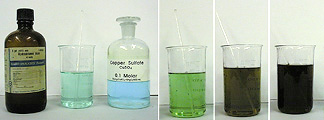When NaBr(s) is added to a solution of CuSO4 and water, what color should it change? Why would AgBr(s) not produce a color change in the same solution?
1 Answer
Feb 24, 2018
For the first question, it is a double replacement reaction, but the second one is nothing!
See the explanation below...
Explanation:
The major clue is that sodium bromide is soluble in water while silver bromide is insoluble in water.
- Cupric sulphate solution (CuSO4) is has a blue colour. So once sodium bromide (which is white crystals) is added to the solution with a little stirring, the solution becomes grey black in colour due to the formation of Cupric Bromide (CuBr2).
2NaBr(aq) + CuSO4(aq) --------> Na2SO4 + CuBr2(aq)
Another approximation we can use instead of sodium bromide is a solution of hydrobromic acid which will give the same result.

- AgBr(s) isn't soluble in water. So when you add it to the blue solution of cupric sulphate, nothing would take place.
Just after stirring, you will see the yellow silver bromide will settle down.

